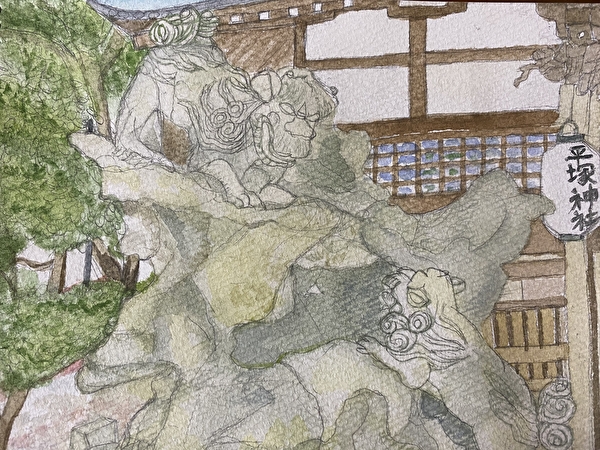「平塚神社の狛犬」
Do you know about Japanese shrines? The komainu of Hiratsuka shrine are unique and komainu have an interesting origin. At 4T-AMKY, Teachers and Students write about Japanese culture, food, history, many spots to visit, and other stuff. Enjoy reading and knowing about deeper Japanese culture!
Komainu (guardian dogs) at Hiratsuka Shrine
Origin
Hiratsuka Shrine is located in Kaminakazato, Kita Ward, Tokyo.
It has rare komainu. This lava mountain is Shishi (Lion) Mountain, which represents “the dropped shishi cub”. The mother shishi standing on top of the mountain on the left is watching over her cub that is crawling up. On the mountain on the right is a male komainu. Some say the one on the left is the father shishi and his cub. The date and origin of these komainu are unknown.
From the expression on thier faces, I felt more tenderness like watching over its own child than the roughness of dropping a child. There seemed to be some kind of story behind the komainu, but I had never seen such dynamic komainu before.

The photo shows the komainu on the right at Hiratsuka Shrine.
I researched komainu online. Komainu are imaginary guardian beast statues dedicated to shrines. They purify evil spirits and protect the shrine. Originally, they were called “shishi and komainu”. On the right side is a shishi with its mouth open and no horns, it’s called “A” shape. On the left side is a komainu with horns and a closed mouth, it’s called “Un” shape.
The “A-Un” shape is said to be unique to Japan, but the distinction between the two is ambiguous and there are many exceptions. The left and right sides of the komainu at Hiratsuka Shrine are also reversed. Both the shishi and komainu are imaginary beasts and are different creatures, but nowadays, the shishi is used as the form and the komainu as the name in many places.

The photo shows Toyouke Shrine (the outer shrine of Ise Shrine) in Tokai Village, Ibaraki Prefecture. There are common Komainu.
At Ueno Toshogu Shrine, where I visited before, there was an explanatory board about komainu (guardian dogs). Here is a part of the explanation as it is easy to understand.
“Komainu is a mythical doglike beast, statues of which are customarily placed in pairs to rebel evil. It is believed that it originated in ancient India, where lion statues were placed as guardian animals for Buddha statues. It is said that it took the form of a shishi in China, and when it was introduced to Japan along with Buddhism via the Korean Peninsula, it came to be represented as a dog.”

Komainu are not only dog-shaped, but can also be other animals such as foxes, cows, and deer. These animals are generally referred to as “shinshi” (messengers of the deities), and some shrines use specific animals. For example, foxes from the Inari Shrine lineage and cows from the Tenmangu Shrine lineage.

The photo shows the main shrine of Oji Inari Shrine in Kita Ward, Tokyo. In keeping with the times, foxes also wore masks.
In addition, before the Meiji era (1868-1912), there was an idea of Shinbutsu Shygo (syncretism of Shintoism and Buddhism), and furthermore, since komainu were introduced with the arrival of Buddhism, they are often found in temples.
The explanatory board at Ueno Toshogu Shrine contains even more interesting descriptions, so I will introduce excerpts of both Japanese and English texts.
“Here, the right -hand Komainu is open-mouthed, which is referred to as “a”, while the left-hand one has a closed mouth, referred to as “un”. As “a” is the first sound in the Japanese syllabary and is pronounced with an open mouth, and “un” is the last one, pronounced with a closed-mouth, “a-un” is said to signify the beginning and end of the universe. This mouth shape is often found in religious statues including komainu, nio and shishi (lion), which are usually placed in pairs.”

The photo shows the komainu on the left at Ueno Toshogu Shrine.
I will pay more attention to komainu when I visit shrines and temples in the future. I’m looking forward to making many new discoveries.
「平塚神社の狛犬」
由来
平塚神社は東京都北区上中里にある神社です。
平塚神社には珍しい狛犬がいます。溶岩造りの山は獅子の子落しを表している獅子山です。左側の山の上に立つ母獅子が這い上がって来る子獅子を見守っています。右側の山には雄の狛犬がいます。左が父子獅子という説もあるようです。年代や謂れは不詳です。
顔の表情から、子落としという荒々しさよりも、我が子を見守る優しさのようなものを感じました。そこには何やら狛犬たちの物語がありそうですが、こんなに躍動感のある狛犬を見たのは初めてでした。
写真は平塚神社にある右側の狛犬です。
狛犬について調べてみました。狛犬とは、神社に奉納された空想上の守護獣像です。邪気を祓(はら)い、神前を守っています。本来は「獅子・狛犬」と言うそうです。向かって右側が獅子で、口を開いた角なしの「阿像」。左側が狛犬で、口を閉じた角ありの「吽像」です。
阿吽(あうん)の形になっているのは日本特有だそうですが、その区別は曖昧で例外も多いようです。平塚神社の狛犬も左右が逆になっています。獅子も狛犬も空想上の獣でそれぞれ別の生き物ですが、現在では形態は獅子、呼称は狛犬となっているところが多いということです。
写真は茨城県東海村にある豊受大神宮です。一般的な狛犬がいます。
以前に参拝した上野東照宮に狛犬についての説明板がありました。わかりやすい説明なので一部紹介します。
「狛犬とは犬に似た日本固有の想像上の生物。古来より、神社仏閣を守ると信じられ、左右一対で奉納されることが多い。古代インドで仏像の守護獣としてライオン像が置かれたものが起源とされている。それが中国で獅子の形となり、仏教とともに朝鮮半島を経て日本に伝わった際に、犬のように表現されるようになったと言われている」
狛犬は犬型ばかりではなく、キツネ、ウシ、シカなどといった他の動物である場合もあります。これらの動物は一般的に「神使(しんし)=神の使い」と言われ、神社によっては特定の動物が使われています。例えば、稲荷神社系のキツネ、天満宮系のウシなどです。
写真は東京北区にある王子稲荷神社の本宮です。時代に合わせてキツネもマスクを着用していました。
また、明治時代以前には神仏習合の思想があり、更に、狛犬は仏教の伝来とともにもたらされたのでお寺にいることも多いようです。
上野東照宮の説明板には更に興味深い記述があったので、日本文、英文ともに抜粋して紹介します。
「当宮の狛犬は左が閉口した吽形、右が開口した阿形で、左右で阿吽(あ・うん)の形となっている。阿は口を開いて最初に出す音、吽は口を閉じて出す最後の音であることから、「阿吽」は宇宙の始まりと終わりを表す言葉とされ、狛犬や獅子、仁王など、一対で存在する神社仏閣の像には阿吽の形がよく見られる。」
写真は上野東照宮にある左側の狛犬です。
これから神社やお寺を訪れた際は狛犬にもっと目を向けてみようと思います。新たな発見が色々ありそうで楽しみです。
Ikuyo.K.






